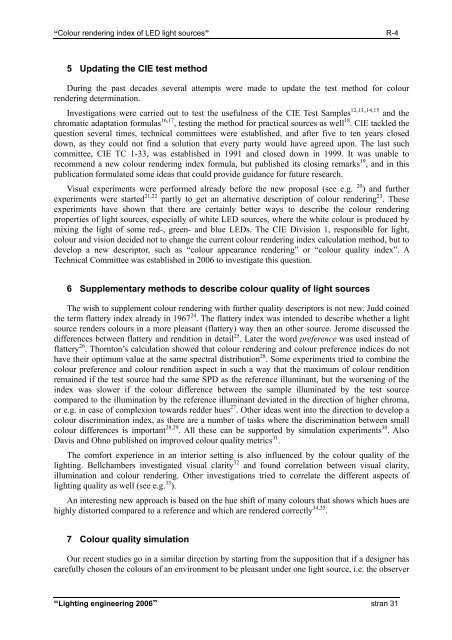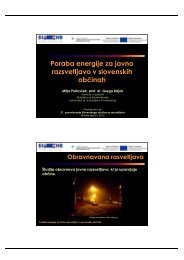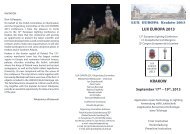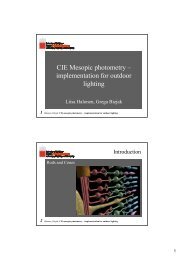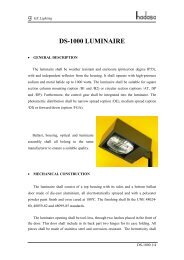Zbornik - SDR
Zbornik - SDR
Zbornik - SDR
Create successful ePaper yourself
Turn your PDF publications into a flip-book with our unique Google optimized e-Paper software.
“Colour rendering index of LED light sources” R-4<br />
5 Updating the CIE test method<br />
During the past decades several attempts were made to update the test method for colour<br />
rendering determination.<br />
Investigations were carried out to test the usefulness of the CIE Test Samples 12,13,,14,15 and the<br />
chromatic adaptation formulas 16,17 , testing the method for practical sources as well 18 . CIE tackled the<br />
question several times, technical committees were established, and after five to ten years closed<br />
down, as they could not find a solution that every party would have agreed upon. The last such<br />
committee, CIE TC 1-33, was established in 1991 and closed down in 1999. It was unable to<br />
recommend a new colour rendering index formula, but published its closing remarks 19 , and in this<br />
publication formulated some ideas that could provide guidance for future research.<br />
Visual experiments were performed already before the new proposal (see e.g. 20 ) and further<br />
experiments were started 21,22 partly to get an alternative description of colour rendering 23 . These<br />
experiments have shown that there are certainly better ways to describe the colour rendering<br />
properties of light sources, especially of white LED sources, where the white colour is produced by<br />
mixing the light of some red-, green- and blue LEDs. The CIE Division 1, responsible for light,<br />
colour and vision decided not to change the current colour rendering index calculation method, but to<br />
develop a new descriptor, such as “colour appearance rendering” or “colour quality index”. A<br />
Technical Committee was established in 2006 to investigate this question.<br />
6 Supplementary methods to describe colour quality of light sources<br />
The wish to supplement colour rendering with further quality descriptors is not new. Judd coined<br />
the term flattery index already in 1967 24 . The flattery index was intended to describe whether a light<br />
source renders colours in a more pleasant (flattery) way then an other source. Jerome discussed the<br />
differences between flattery and rendition in detail 25 . Later the word preference was used instead of<br />
flattery 26 . Thornton’s calculation showed that colour rendering and colour preference indices do not<br />
have their optimum value at the same spectral distribution 28 . Some experiments tried to combine the<br />
colour preference and colour rendition aspect in such a way that the maximum of colour rendition<br />
remained if the test source had the same SPD as the reference illuminant, but the worsening of the<br />
index was slower if the colour difference between the sample illuminated by the test source<br />
compared to the illumination by the reference illuminant deviated in the direction of higher chroma,<br />
or e.g. in case of complexion towards redder hues 27 . Other ideas went into the direction to develop a<br />
colour discrimination index, as there are a number of tasks where the discrimination between small<br />
colour differences is important 28,29 . All these can be supported by simulation experiments 30 . Also<br />
Davis and Ohno published on improved colour quality metrics 31 .<br />
The comfort experience in an interior setting is also influenced by the colour quality of the<br />
lighting. Bellchambers investigated visual clarity 32 and found correlation between visual clarity,<br />
illumination and colour rendering. Other investigations tried to correlate the different aspects of<br />
lighting quality as well (see e.g. 33 ).<br />
An interesting new approach is based on the hue shift of many colours that shows which hues are<br />
highly distorted compared to a reference and which are rendered correctly 34,35 .<br />
7 Colour quality simulation<br />
Our recent studies go in a similar direction by starting from the supposition that if a designer has<br />
carefully chosen the colours of an environment to be pleasant under one light source, i.e. the observer<br />
“Lighting engineering 2006” stran 31


